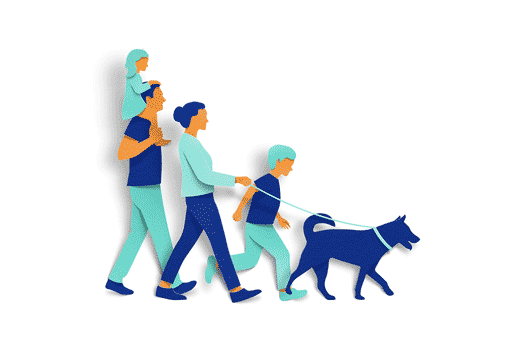Seven simple steps to become a first time buyer
November 2025


Seven simple steps to become a first time buyer
June 2024
Are you a first time buyer? Then you’re in the right place. We know that getting started with the home buying process can be daunting – and quite frankly, a little confusing! But we’re here to help.
In this blog, we’ll walk you through seven steps to help you get started.
1. Getting to know the jargon
You certainly don't need to learn all the words used in the mortgage market, but here are a few it might be handy to know.
LTV - Loan to Value - this is the amount you want to borrow via a mortgage compared to the value of the home you want to buy.
For example, let’s say the value of your first home is £200,000 and you need to borrow £160,000. Your LTV would be 80%.
The larger your deposit, the lower the LTV will be. And you'll find that lots of lenders offer lower mortgage interest rates for customers who put down a larger amount up front.
APRC - Annual Percentage Rate of Charge - this is the total cost of the mortgage shown as an annual percentage. All lenders calculate APRC the same way to help you compare mortgage details. This rate could change if a variable rate applied to you rmortgage changes (e.g. Standard Variable Rate (SVR)).
AIP - Agreement in Principle - this is a statement from a lender to say that 'in principle', they'll lend you a certain amount. To get this, you have to share some information with them – like your income and outgoings. At this stage, an AIP is just an indication of what you might be able to borrow. You'll still need to complete a full application as part of the mortgage process.
Mortgage application – you need to fill one of these out to formally request your loan from a lender.
You might talk to a lender directly or mortgage broker. Each will talk you through your mortgage needs, look at your budget, when you'd next like to review your mortgage, any plans to overpay or future plans to move. This will help give them an idea of what's important to you so they can suggest a mortgage based on your needs.
Valuation of the property - once your application has been sent, your lender will ask for a valuation of the home you want to buy. This is to make sure that you're paying the right amount for it. It might also be a good idea to do one of these yourself.
Mortgage offer - once the valuation and income checks have been done, a copy of your mortgage offer will be sent to you and your solicitor. This is the official confirmation from a lender of how much they're willing to lend you.
Conveyancing solicitor - you'll need a conveyancing solicitor to cover all the legal aspects for you. They'll do the right checks to make sure you're protected so your purchase can go ahead without any problems.
House prices can go up and down based at any time. It's a good idea to have a look at the prices for the area where you'd like to live. This will give you a good idea of what's you can afford.
The UK House Price Index is a useful set of government stats that shows national price averages and price changes for different types of property. And if you have your heart set on a particular area, the data also tracks average prices in regions across the country.
2. Check what you can afford
Look at your budget and setting a realistic deposit target.
Deposits usually range from 5% to 20% of a home’s value1. So, if you're buying a property worth £250,000, a 10% deposit would be £25,000. Take a look at our affordability calculator to help you work out how much you could borrow?
Keep in mind, the cost of buying a home isn't just the amount you pay for it. It also includes other expenses like surveys, product fees and legal fees. Lots of first time buyers don’t know about these costs – which is why we’ve published hidden costs for first time buyers.
3. Start your savings journey
Your savings will play a starring role to help you get a home. Getting in to a habit of putting money away regularly, even in small amounts, will build up that all-important deposit.
There are so many savings accounts to choose from. And did you know, some are made with home savers in mind? Like our First Home Saver account. With this account you can pay in up to £1,000 a month for 36 months. We’ll also add a £500 bonus if you buy your first home with a mortgage from us. You can access your money charge-free, subject to 60 days' notice.
Another option is to choose a cash ISA. ISAs usually provide a good rate of growth on your savings because they are tax-free.
4. Build your credit history
When you apply to borrow money for a home, the lender will run a credit check on you. This is where the lender reviews your financial history to see how you've handled money and debts in the past. If you have a good history of taking on debt and paying it back on time it will improve your chances of getting a mortgage.
Your score is an approximate reflection of how reliable you are with money. Paying bills when they're due, not maxing out credit cards, and not applying for too much credit at once can help boost your score.
Don't worry if you're only just starting to think about this. You can find out more about how to check your credit score and ways to improve this in our first time buyer guide.
5. Consider mortgage options
Have you thought about how long you want your mortgage to run? A shorter term means you'll pay off your mortgage quicker, and usually with less interest to pay in total. But stretching the term over more years will make your repayments smaller and easier to manage.
If you go for a fixed rate deal, you’ll know exactly what you’re due to pay each month. But with variable rate mortgages, even though you’ll pay more if rates increase, you could save money if rates drop.
Whichever route you go, it's important you understand each option to make the right choice that gives you peace of mind. At Coventry Building Society, we'll help guide you and give you all the key information you need.
6. Explore homeownership schemes
You may find that buying a home feels out of reach and that it's difficult to save a deposit. If that sounds familiar, there’s a few routes you could take a look at.

The First Homes scheme is another government-backed initiative worth exploring. If you and the home meet the requirements, you could buy at a 30% to 50% discounted rate2.
7. Speak with an expert
We know there’s lots of information here to digest, but you don't have to start your journey to own a home all by yourself. It's much easier to talk to our friendly team of mortgage advisors. They can guide you through our range of options to help you on your way.
You could also sit down with a broker. They’ll also be able to help you through the process, handle the paperwork and negotiate with lenders on your behalf.
Your first home is out there! And don’t forget, our Knowledge Centre has lots of useful information to get ready for your first home.
- Source - Homebuyers4u - How Much You Need for a House Deposit
- Source - First Homes scheme: first-time buyer's guide: Overview - GOV.UK
Information correct as at November 2025.
Related articles:

How to become a savvy saver
Navigating your savings journey by making smart choices.
Things are looking up for those with a goal to step onto the housing ladder. Higher interest rates and the cost of living crisis have made it hard for buyers in recent years. With inflation down to more normal levels of 2.3%, its lowest level in almost three years, interest rates are expected to come down later in the year, making mortgages more affordable.
If you’ve ever dreamt of owning your own home, now could be the perfect time to start saving towards that dream. In this blog, we’ll walk you through seven steps to put yourself in a prime position for homeownership.
1. Understanding the jargon
You certainly don’t need to learn all the words used in the mortgage market, but here are some common ones that might come in handy on your road to homeownership.
LTV – Loan to Value – this is the amount you want to borrow via a mortgage compared to the value of the home you want to buy.
For example – the value of your first home is £200,000 and you need to borrow £160,000, then the LTV is 80%.
The larger the deposit you’re able to save toward the cost of your first home, the lower the LTV will be. And you’ll find that many lenders offer lower mortgage interest rates for customers who have saved a bigger deposit.
APR – annual percentage rate – the interest rate which is charged on your mortgage over the year and which will inform how much interest you pay as part of your monthly mortgage repayments.
AIP - Agreement in Principle – this is a statement from a lender to say that ‘in principle’, they’ll lend you a certain amount. It’s based on you providing them with some information, such as your income and outgoings, without having to go through a full mortgage application. At this stage it’s just an indication, you’ll need to complete a full application as part of the mortgage process.
Mortgage application – Whether you talk to a lender directly or an independent expert mortgage advisor, they'll talk you through your mortgage needs, covering your budget, when you’d next like to review your mortgage, any plans to overpay or future plans to move. This will enable them to build a picture of what’s important to you and recommend a mortgage based on your needs.
Valuation of the property – once your application’s been submitted the lender instructs a valuation of the property, this is to make sure that you’re paying the right amount for it.
Mortgage offer – once the valuation has been received and income checks have been completed a copy or your mortgage offer will be sent to you and your solicitor.
Conveyancing solicitor – you’ll need a conveyancing solicitor to cover all the legal aspects for you. They’ll complete checks to make sure you’re protected, and your purchase can go ahead without any problems.
House prices can go up and down based on lots of factors, such as the economy and where other people are looking to buy. It’s a good idea to have a look at the house prices for the area where you’d like to live. This will give you a good idea of what’s affordable for you.
The UK House Price Index is a useful set of government statistics showing you national price averages and price changes for different types of property. And if you have your heart set on a particular area, the data also tracks average prices in regions across the country, so keep an eye on how these figures change.
2. Check what you can afford
Knowing what you can comfortably afford is the next step.
Start by calculating your budget and setting a realistic deposit target, which typically ranges from 5% to 20% of a property’s value1. For example, if you’re buying a home worth £250,000 then a 10% deposit would be £25,000. To make things easier, you can use our affordability calculator to help you work out how much you could borrow.
Keep in mind, the cost of buying a home isn't just the purchase price. It includes other expenses like surveys, product fees and legal fees. Our research recently found that many first time buyers are not aware of most of these costs2.
That's why we've published a guide to some of the most common hidden costs for first time buyers.
3. Start your savings journey
Your savings will play a key role in your homeownership journey, so cultivating a habit of putting money away regularly, even in small amounts, will help build up that all-important deposit.
There are plenty of different savings accounts to choose from and some are specifically designed with home savers in mind. We offer a First Home Saver account that gives you a £500 bonus if you take out a mortgage with us. You can also access your money charge-free, subject to 60 days’ notice.
Another option is to choose a Cash ISA. Individual Savings Accounts (ISAs) provide a comparatively good rate of growth on your savings because they are tax-free.
4. Build your credit history
When you apply to borrow money for a home, the lender will run a credit check on you. This is where the lender reviews your financial history to see how you've handled money and debts in the past. If you have a good history of taking on debt and paying it back on time it will improve your chances of getting that all-important mortgage.
Your score is an approximate reflection of how reliable you are with money – paying bills when they’re due, not maxing out credit cards, and not applying for too much credit at once can help boost your score.
Don’t worry if you’re only just starting to think about this. Anyone can improve their rating!
5. Consider mortgage options
Have you considered how long you want your mortgage to run? A shorter mortgage term means you'll pay off your mortgage quicker, and usually with less interest to pay in total. But stretching the term over more years will make your repayments smaller and easier to manage.
If you go for a fixed-rate deal, it can be reassuring because you know exactly what you'll pay each month. With variable-rate mortgages, however, although you will pay more if rates increase, you could save money if rates drop.
Whichever route you go, it’s important you understand each option in order to make the right choice that gives you peace of mind. At Coventry Building Society, we’ll guide you through these choices with all the key information you need.
6. Explore homeownership schemes
You may find that buying a home feels out of reach and that it’s difficult to save a deposit. If so, don’t stress – there are affordable ways to become a homeowner.
The Shared Ownership scheme is an option worth considering. In the scheme, you buy between 25% to 75% of the value of the home – that’s your share, and the rest of the home is owned by a housing association. You pay a mortgage on your portion and some rent on the other portion. As you’re not buying the whole house immediately, this method reduces the size of the initial deposit and mortgage you will need. In your own time, you can gradually buy the rest of your home, growing your share.

The First Homes Scheme is another government-backed initiative worth exploring. If you and the home meet the requirements, you could buy at a 30% to 50% discounted rate3.
7. Speak with an expert
This is a lot of information to take onboard – but you don’t have to navigate the homeownership journey all by yourself. It’s much easier to talk to our friendly team of mortgage advisers who can guide you through our range of mortgage options to help you on your way to homeownership.
Another option is to sit down with a mortgage broker who can further clarify the mortgage process, handle the paperwork and negotiate with lenders on your behalf.
Your first home is out there. Our Knowledge Centre has lots of useful information to help you prepare for homeownership. Whether you're starting to save or moving in, we're here to help!
- Source - Homebuyers4u - How Much You Need for a House Deposit
- Source - First time buyer economy report
- Source - GOV.UK First Homes scheme: first-time buyer's guide
Information correct as at June 2024.
Related articles:

How to become a savvy saver
Navigating your savings journey by making smart choices.


